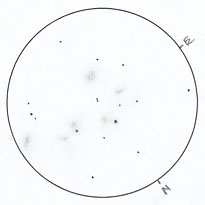 Sextans isn't much to look at as constellations go. But it holds some surprises for the dedicated deep-sky observer. One, is the galaxy cluster pictured at left. The sketch, based on the view in the 18-inch Obsession at 199X, is centered on a faint double star. A 9.8 magnitude star shines 2'.3 to the north. NGC 3092 is the 13th magnitude galaxy positioned 2' to the south. The galaxy covers a 1'x0'.5 area. 14th magnitude NGC 3093 covers a 0'.7x0'.2 patch of sky and stands 2'.3 east of the double.
Sextans isn't much to look at as constellations go. But it holds some surprises for the dedicated deep-sky observer. One, is the galaxy cluster pictured at left. The sketch, based on the view in the 18-inch Obsession at 199X, is centered on a faint double star. A 9.8 magnitude star shines 2'.3 to the north. NGC 3092 is the 13th magnitude galaxy positioned 2' to the south. The galaxy covers a 1'x0'.5 area. 14th magnitude NGC 3093 covers a 0'.7x0'.2 patch of sky and stands 2'.3 east of the double.
PGC 28963 is a 14.0 magnitude galaxy visible about an arcminute southwest of of the aforementioned 9.8 magnitude sparkler. A 10.5 magnitude star resides another 2'.6 due west. NGC 3090, a 12.2 magnitude elliptical galaxy, lies about 45" south of this star and covers less than a 30" diameter area. This is the bright central core of the galaxy. The elogated stellar metropolis standing just inside the west field boundary is NGC 3086. It's aligned northwest to southeast and covers a pencil thin 1'.2x0'.2 area.
The sixth and last galaxy in my rendering is 2MASX J10002693 -0256503. It emerges as a delicate foggy haze about an arcminute west of the 10.5 magnitude star. Barely 0'.2x0'.1 in size, this object flashes to the eye with averted vision, always appearing in the same location. The 2MASS J-band photometru suggests a visual magnitude of roughly 14.5. You'll find this cluster about 5.5 degrees northeast of 5.1 magnitude Gamma (8) Sextantis. |
![]()
![]()
